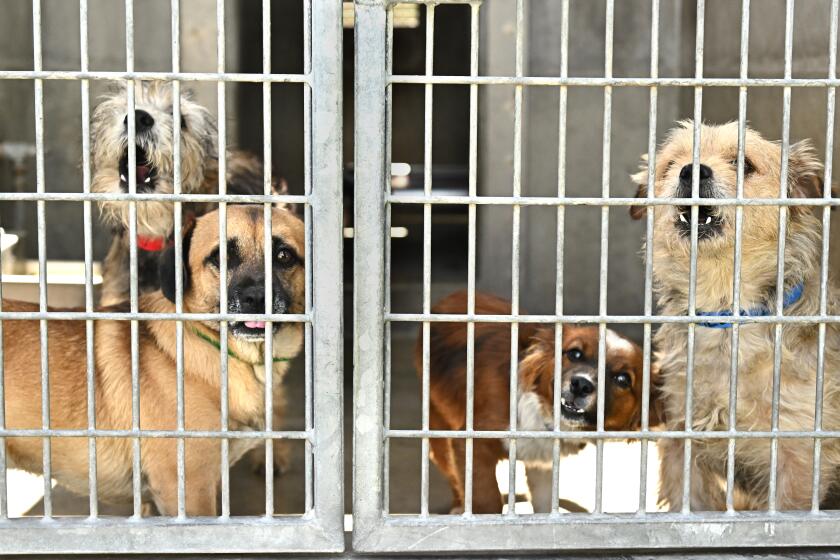Young bear is entering picnic areas
When a bear decides it’s a fine idea to hop aloft a picnic table surrounded by people, something clearly has gone wrong. But officials say the bear is not to blame.
In fact, the bear that forced the closure of a picnic area next to San Bernardino National Forest’s busiest trailhead on July 7 had adapted to a quick and easy food source: hot dogs and other human fare left out, sometimes intentionally, by picnickers and area residents.
“People were leaving a lot of food unattended, they weren’t properly throwing it away in the bear-proof cans. There was even reported cases where people were intentionally feeding the bear,” said John Miller, deputy public affairs officer for the U.S. Forest Service. “We have a human behavior problem.”
Once bears learn to associate human scent with easy food sources, they are more likely to venture into picnic areas, according to Jeff Villepique, associate wildlife biologist at the California Department of Fish and Game.
Picnickers have reportedly reinforced the behavior by tossing food at the bear and getting up close to take photos.
“The bear has pretty much lost its fear of humans,” said Villepique.
Although the bear is only about a year and a half old, and weighs about 120 pounds, Villepique said, it could still pose a threat to picnickers who refuse to surrender meals, or to infants who happen to be sitting too close to food. American black bears have been known to attack humans in order to eat them. A 74-year-old woman in Colorado who had been leaving food out for bears was killed outside her house Friday. Her body had been partially consumed by bears, authorities said.
If the bear doesn’t learn to stay away, Villepique said, officials most likely will have to euthanize it.
The Forest Service and Department of Fish and Game plan to patrol picnic areas near Vivian Creek trailhead until after Labor Day. Officials have set up two new bear-proof dumpsters, posted warning signs and made attempts to educate the public. The area reopened Saturday, and so far the bear has not turned up again.
Villepique said that’s a good sign. “Both species are happier if there’s some space between us,” he said.
-- Amy Littlefield
West to get more wildfires, worse air
A projected increase in wildfires in coming decades would be bad news for Western lungs.
Harvard University scientists are predicting that some forms of air pollution could increase significantly across the West as more of the region’s wildlands burn as a result of rising temperatures.
Smoke from wildfires contains two main kinds of carbon particles: black soot, or elemental carbon, and lighter-colored particles, called organic carbon aerosols, which are a mix of chemicals.
“In large quantities, downwind of fires, organic carbon aerosols are hazardous,” said Senior Research Fellow Jennifer Logan, who led a study examining rising wildfire rates and their effect on air quality. “The particles irritate lung tissue and the chemicals they carry are toxic. But even at low concentrations, these aerosols may be dangerous. . . . There is no known threshold where damage begins.”
The research, published in the June 18 issue of the Journal of Geophysical Research, estimates that summertime levels of carbon aerosols could rise 40% across the West between 2000 and 2050. Concentrations of elemental carbon could increase 20%.
In areas facing more dramatic wildfire increases, such as the Sierra, the Pacific Northwest and the northern Rockies, carbon aerosol production could be even greater.
Studies in recent years have linked rising temperatures to increased wildfires in some parts of the West. Warmer weather lengthens the fire season and dries out forest growth.
Using a series of models, Logan and her colleagues at Harvard’s School of Engineering and Applied Sciences predicted that the amount of land burned in the West could jump roughly 50% by the 2050s compared to today.
-- Bettina Boxall
Army again asks to relocate tortoises
As it prepares to expand training operations at Ft. Irwin in the Mojave Desert, the Army is proposing to move more than 1,100 threatened California desert tortoises -- an unprecedented number of an endangered species that has not fared well during previous relocation efforts.
The Army is seeking the approval of the federal Bureau of Land Management to move the tortoises from nearly 100,000 acres in portions of the National Training Center to lands managed by the bureau.
The Army began relocating more than 600 of the reptiles last year but suspended the $8.7-million program after officials noted high mortality rates among the tortoises, chiefly because of coyotes.
About 90 tortoises were found dead from suspected coyote predation. But Clarence Everly, natural and cultural resources program manager at Ft. Irwin, said only one died during the relocation.
The sheer number of tortoises to be moved in the proposed operation alarms conservationists.
“Nothing’s ever been done on this scale before,” said Ileene Anderson, a biologist with the Center for Biological Diversity who says 252 tortoises have died in the translocation area. “Every time the animals recognize that they don’t know where they are, they have some built-in mechanism that tells them to head for home.”
After the last move, some tortoises traveled up to five or six miles to get back to their home range, Anderson said.
-- Julie Cart
--
Visit latimes.com/greenspace for environmental news from California and beyond.
More to Read
Start your day right
Sign up for Essential California for news, features and recommendations from the L.A. Times and beyond in your inbox six days a week.
You may occasionally receive promotional content from the Los Angeles Times.






